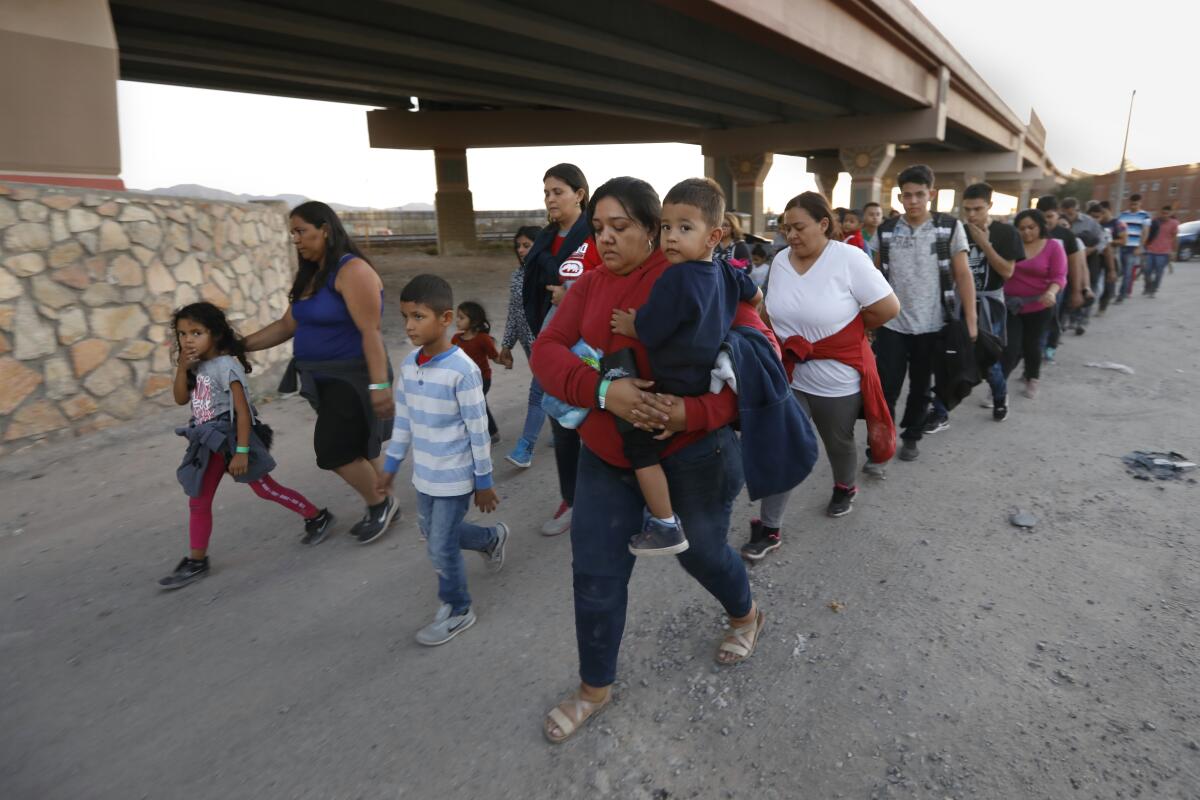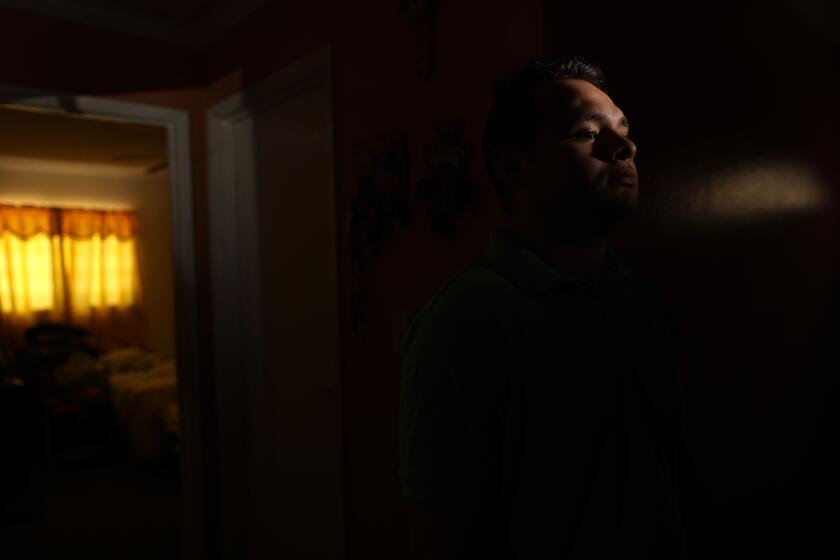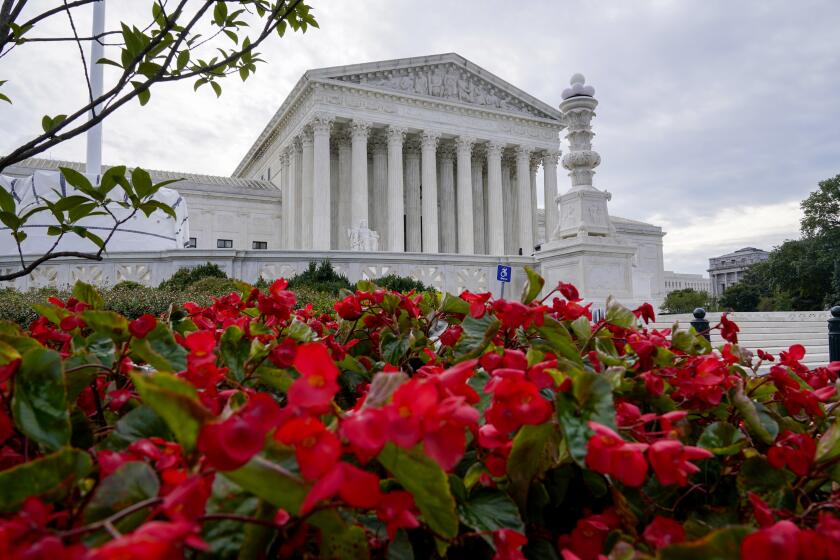Trump administration plans to end limits on child detention

- Share via
WASHINGTON — The Trump administration is moving to dismantle decades-old protections for immigrant youth, rolling out new regulations that would give the government the ability to indefinitely detain minors and families with children.
President Trump and his aides have long railed against the so-called Flores agreement, the seminal 1997 court settlement that said the government must provide a minimum standard of care for migrant children in U.S. custody. In 2015, as the Obama administration struggled to respond to an influx of unaccompanied minors at the southern border, the agreement was strengthened. Generally, the government must release children as quickly as possible and cannot detain them longer than 20 days, whether they have traveled to the U.S. alone or with family members.
The new regulations, expected to be formally published Friday, will take effect in 60 days, absent legal challenges. Lawyers who argued the original case will have a week to oppose the final regulations if they fall short of the terms of the Flores settlement. Advocates had already sought to block the regulations when the Trump administration first proposed them last September, and lawsuits are expected immediately.
Acting Homeland Security Secretary Kevin McAleenan said at a news conference Wednesday that the Flores settlement is the primary driver for Central American families coming to the U.S. border, and that once it is ended, numbers will drop dramatically.
“The driving factor for this crisis is weakness in our legal framework for immigration,” McAleenan said. “This single settlement has substantially caused, and continues to fuel, the current family unit crisis ... until today.”
Trump’s new policy on unaccompanied minors is an extension of his strategy to make asylum more difficult for practically anyone to obtain.
Trump said later Wednesday at the White House that the new regulations show strength on border security, while also framing them as humanitarian measures. He repeated false claims that his predecessor, President Obama, is the one who started separating immigrant families. Debate over the Flores agreement flared up last year when the Trump administration publicized a policy of prosecuting anyone caught crossing the border illegally, and separated at least 2,900 children from their parents. The total number of separated children remains unknown.
“Very much I have the children on my mind. It bothers me very greatly,” Trump told reporters on the White House lawn before leaving for an event in Kentucky. “When they see you can’t get into the United States ... they won’t come. And many people will be saved. Many women’s lives will not be destroyed.”
“President Obama had separation,” he added. “I’m the one that brought them together. This new rule will do even more to bring them together.”
The regulations escalate a heated fight over not only the Trump administration’s ability to hold migrant families, but also its willingness to do so humanely. As Trump has largely failed to deter near-record migration to the southern border, made up of mostly Central American families seeking asylum, a spate of immigrant children and adults have died in U.S. custody, and immigration authorities have repeatedly been found to be providing sub-standard care for detained migrants.
A federal appeals panel found last week that detained children should get edible food, clean water, soap and toothpaste under the agreement, after a bid by the Trump administration to limit what must be provided.
Critics, including a lawyer for the immigrant children in the original Flores case, immediately rejected the new regulations as politically motivated. Trump ran for the White House on harsh rhetoric against immigrants and pledges to restrict migration, both of which he has made central to his reelection effort.
“I think all these things are now part of the 2020 campaign,” said Peter Schey, a lawyer for the immigrant children in the Flores case and president of the Center for Human Rights and Constitutional Law.
If the new regulations don’t match the settlement, Schey said, “they would be in immediate material breach, if not contempt of court.”
Lawyers in the Flores case recently spoke out about what they said were deplorable, filthy conditions for children held at border facilities not meant to hold large groups of people for very long. And a recent report by an independent monitor overseeing claims of government noncompliance with Flores rules detailed the extreme overcrowding and poor conditions that immigrant youths faced in detention.
Clara Long, acting deputy Washington director for Human Rights Watch, documented conditions for migrant children under the Flores settlement with a team of migrant advocates at a troubled Border Patrol station this summer in Clint, Texas.
She said hundreds of children had been held in the cramped station for weeks on end, unable to bathe, some forced to babysit unrelated babies detained without their parents.
“Deterrence is not a permissible ground to justify the detention of asylum seekers under international law,” Long said.
Clint had a capacity for 105 children; on June 1, there were 676, according to the Associated Press. At a detention center in McAllen, Texas, there were nearly 1,800 juveniles alone, when the entire capacity for both youth and adults was 1,500.
After Long and other advocates publicly criticized the Border Patrol, the agency transferred children from the station and conditions started to improve. But if the proposed rule takes effect, Long said it would likely bar such visits by migrant advocates to Border Patrol detention facilities, allowing conditions for migrant children to quickly deteriorate.
“One of the things we’re losing along with the weakening standards and the core elements of Flores -- that children have to be released expeditiously -- is an enforcement mechanism,” Long said. “There’s huge reason to be deeply concerned about the conditions in those facilities without outside monitoring.”
Homeland Security officials say the new regulations reflect the agreement, which was only meant to be temporary. They said they are creating a set of higher standards to govern family detention facilities, which will be regularly audited, and the audits made public. But the rules would allow the government to hold families in detention until their immigration cases are completed, which could be much longer than 20 days.
The district judge overseeing the agreement has already refused government requests to increase the amount of time children can be detained.
McAleenan would not say how long Homeland Security expects families to be kept, but pointed to an average time frame in detention of under 50 days that he said predated the 2015 strengthening of the Flores agreement.
Asylum cases involving detained families tend to move much more quickly than cases for families released, typically taking months instead of years to resolve.
But experts say the Trump administration has also given misleading statistics to bolster its argument that such regulations to keep families and other immigrants detained are necessary to avoid a practice that the president has derided as “catch and release.” Trump officials say that parents and children released into the United States while their asylum requests wind their way through the courts do not show up for hearings.
Yet for nearly 47,000 recently arrived asylum-seeking families, close to 86% released from custody attended their initial hearings, according to an analysis of Justice Department data by the Transactional Records Access Clearinghouse at Syracuse University. With a lawyer, it was 99%.
Long-term detention can also mean long-term damage to migrant families’ health, experts say.
Long, of Human Rights Watch, has researched the effect of lengthy detention on immigrant families, interviewing those held for up to a year in 2015. She added that the 50-day average families spent in detention before the strengthened Flores rule was imposed in 2015 was misleading “because families often gave up their asylum claims” rather than remain there.
“It took a severe psychological toll on children. They reported depression, trauma, suicidal feelings,” Long said. “That was the model that was explicitly referenced [by McAleenan] as what we’re returning to.”
Based on the proposed rule, which was submitted last fall, and the administration’s efforts to restrict monitoring under Flores, Hope Frye, a lawyer based in the Bay Area, fears the new rule could limit access to detention facilities for those monitoring the government’s compliance with Flores. Frye interviewed migrant children held at Border Patrol stations in Texas’ Rio Grande Valley in June as part of a team of Flores monitors.
Frye noted the proposed rule would also end state licensing requirements for DHS migrant child detention facilities. Licensing requirements have been suspended in the past for massive emergency shelters in Tornillo, Texas, and Homestead, Fla., that migrant advocates faulted for being overcrowded.
“If you end monitoring, you silence the voices of the children and nobody externally will know what’s happening to them, the real story,” said Frye, executive director of Project Lifeline, a nonprofit providing legal and medical services to migrant children. “If there’s nobody to look, then who’s going to say?”
The government currently operates three family detention centers that can hold a total of about 3,000 people, though one is being used for single adults, and the other two are at capacity. Officials hope they would not need extra bed space because the rules would serve as a deterrent.
The influx of Central American families to the U.S.-Mexico border has vastly strained the U.S. immigration system, which has been primarily geared toward single adult Mexican men. The Border Patrol has apprehended more than 430,000 individuals in family units at the southern border so far in fiscal 2019 – more than triple the apprehensions during all of last fiscal year, according to the White House.
At the same time, officials have seen a nearly 50% decrease in apprehensions of unaccompanied minors and family units at the border since May. They credit an agreement with Mexico to clamp down on migrants heading north for helping reduce the flow, and the Trump administration is pursuing further steps to block asylum at the southern border altogether, though the actions have been decried as inhumane.
With an influx of emergency funding from Congress, the overcrowding crisis that Homeland Security officials blamed for poor conditions in detention has largely abated, senior officials at Border Patrol and Customs and Border Protection told reporters this month.
Part of the issue in 2015, when the Obama administration tried to detain families and children together until their cases were completed, was that children could not be kept in facilities that weren’t licensed, and no states license family detention centers.
Homeland Security officials say that with the new regulations, adopting the standards for education, healthy food and cleanliness used by U.S. Immigration and Customs Enforcement, which detains adult immigrants, they are satisfying requirements in lieu of state licensing requirements.
Yet lawmakers called on the courts Wednesday to block the new regulations, saying they will lead to “deadly consequences.”
“When children have repeatedly died in our care for ailments as simple as the flu, keeping them in indefinite detention defies logic and will lead to deadly consequences,” said Rep. Bennie Thompson (D-Miss.), chairman of the House Homeland Security Committee. “The courts must immediately stop this illegal action.”
The Associated Press contributed to this story.
More to Read
Get the L.A. Times Politics newsletter
Deeply reported insights into legislation, politics and policy from Sacramento, Washington and beyond. In your inbox twice per week.
You may occasionally receive promotional content from the Los Angeles Times.













